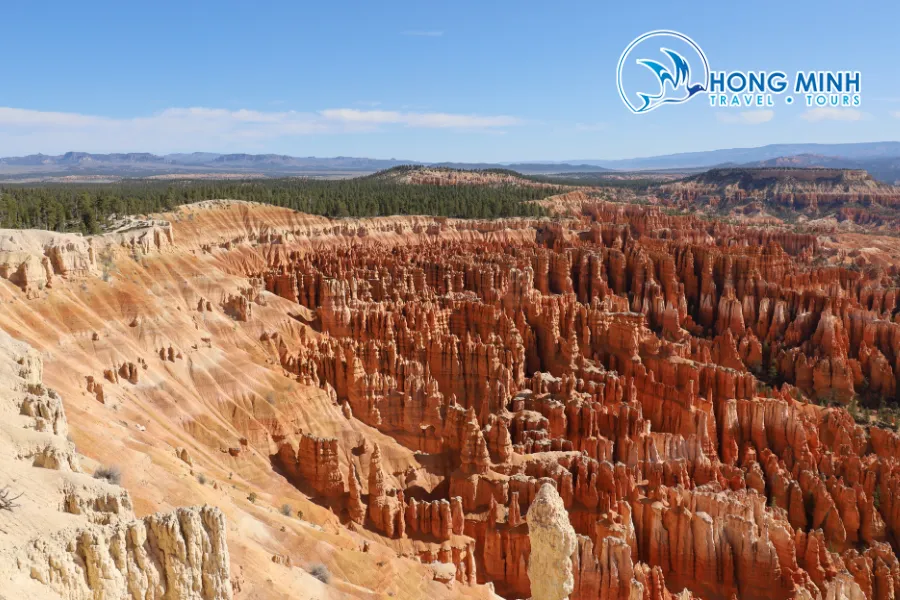Utah, renowned for its magnificent natural landscapes, is a paradise for travel and photography enthusiasts. It boasts unique natural rock formations sculpted by millions of years of erosion, offering countless opportunities to capture stunning moments. Let’s explore Bryce Canyon and Zion National Park, two gems of Utah, for an unparalleled photography experience.
Bryce Canyon: Nature’s Colorful Symphony
Bryce Canyon is not actually a canyon, but a collection of giant natural amphitheaters formed by the erosion of water and ice. The most distinctive feature of Bryce Canyon is its Hoodoos, pillars of rock in bizarre shapes, creating a surreal and incredibly impressive landscape.
Best Time to Photograph Bryce Canyon
Light is the key to capturing beautiful photos at Bryce Canyon. The ideal times for photography are sunrise and sunset, when the sunlight shines at an angle, highlighting the details and colors of the Hoodoos. Early morning, when mist still lingers over the amphitheaters, creating a mystical scene, is also a great time to unleash your creativity.

Top Photography Spots in Bryce Canyon
- Sunrise Point and Sunset Point: These are the two most famous viewpoints in Bryce Canyon, where you can admire panoramic views of the amphitheaters and Hoodoos.
- Inspiration Point: This viewpoint offers a broader perspective of Bryce Canyon, allowing you to capture impressive wide-angle shots.
- Navajo Loop Trail and Queen’s Garden Trail: These trails lead you down into the canyon, allowing you to explore and photograph the Hoodoos up close.
- Thor’s Hammer: One of the most famous Hoodoos in Bryce Canyon, with a unique shape resembling Thor’s hammer.
- Rainbow Point and Yovimpa Point: From here, you can admire the entire “stone forest” interspersed with fleeting clouds, creating a stunning picture.
Tips for Photographing Bryce Canyon
- Use a wide-angle lens: To capture the vastness of Bryce Canyon, a wide-angle lens is an excellent choice.
- Use a tripod: To ensure sharp images, especially when shooting at sunrise and sunset, use a tripod.
- Shoot in HDR: HDR (High Dynamic Range) photography technique helps you balance the highlights and shadows in your photos, especially when shooting in complex lighting conditions.
- Look for unique angles: Instead of just shooting from familiar viewpoints, try exploring and finding unique angles to create impressive photos.
- Shoot portraits: Bryce Canyon is also a great location for portrait photography. Take advantage of the majestic scenery and natural light to create unique and impressive portraits.
Zion National Park: Majestic Canyon Beauty
Zion National Park is famous for its towering sandstone canyons, winding rivers, and lush forests. It offers a majestic and magnificent beauty, completely different from Bryce Canyon.
Best Time to Photograph Zion National Park
Similar to Bryce Canyon, the ideal times to photograph Zion National Park are sunrise and sunset. However, due to the deep and narrow canyons, the light in Zion National Park can change very quickly. Be prepared to take advantage of the most beautiful moments of light.

Top Photography Spots in Zion National Park
- The Narrows: One of the most popular attractions in Zion National Park, where you can hike in the Virgin River and admire the towering canyon walls.
- Angels Landing: A challenging trail leading to the top of a rock formation, offering stunning views of Zion Canyon.
- Observation Point: This viewpoint offers a panoramic view of Zion Canyon, including Angels Landing and The Virgin River.
- Checkerboard Mesa: A sandstone formation with horizontal and vertical lines, creating a unique pattern.
- Emerald Pools: A series of waterfalls and emerald pools, creating a picturesque scene.
Tips for Photographing Zion National Park
- Use both wide-angle and telephoto lenses: To capture the vast panoramic views of the canyon, you need to use a wide-angle lens. However, to capture small details on the canyon walls, you also need to use a telephoto lens.
- Use a polarizing filter: A polarizing filter helps reduce glare and increase contrast in your photos, especially when shooting in bright light conditions.
- Shoot in shade: On sunny days, the light in the canyon can be harsh. Look for shaded areas to shoot, which helps reduce contrast and create better photos.
- Shoot reflections: The Virgin River is a great place to shoot reflections. Look for locations with calm water to capture impressive reflection shots.
- Shoot at night: Zion National Park is an excellent location for night sky photography. With clear skies and low light pollution, you can capture stunning photos of the Milky Way and stars.
Photographing Utah’s Natural Rock Formations: A Rewarding Experience
Photographing Bryce Canyon and Zion National Park is a journey to explore the magnificent beauty of nature. This place is not only an ideal destination for professional photographers but also an endless source of inspiration for those who love the wild and majestic beauty of creation. Come and experience it for yourself, capturing memorable moments on your journey to discover Utah.